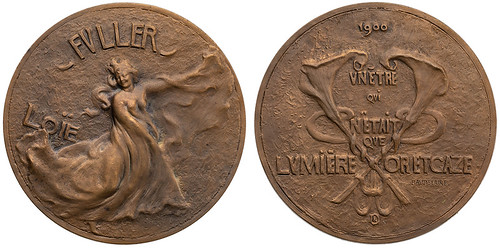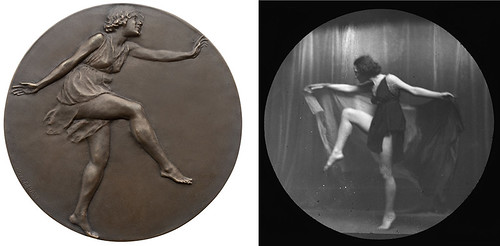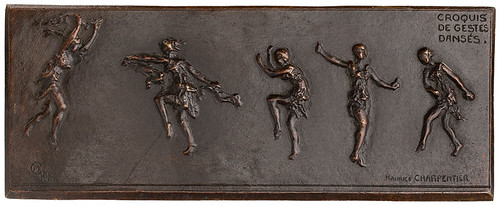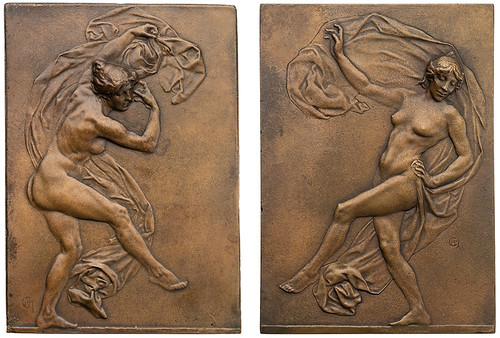
PREV ARTICLE
NEXT ARTICLE
FULL ISSUE
PREV FULL ISSUE
V25 2022 INDEX E-SYLUM ARCHIVE MEDALLIC REPRESENTATIONS OF DANCEIn a recent American Numismatic Society Pocket Change blog article, Scott Miller discusses medallic representations of dance. Here's an excerpt - see the complete article online for more great illustrations. -Editor As with other forms of decorative art in turn of the century France, medals were a part of popular culture just as they were a part of the art world. Whether produced for widespread distribution, or in limited numbers, they remain as contemporary illustrations of iconic people and events which help define the popular idea of France during the Belle Époque. Though little known today, it should not come as a surprise that dancers were a common theme for medals created during the period. The Société des Amis de la Médaille Française (SAMF) was the brainchild of Roger Marx, who was employed by the French government as Inspecteur Général des Musées des Départements. He was also one of the great promoters of decorative arts, including posters, prints, and medallic art. Founded in 1899, the SAMF issued several medals each year, examples of which were available for purchase by members in silver and bronze. A medal by Pierre Roche was issued at the time of the 1900 Universal Exposition then being held in Paris. It depicted Loïe Fuller, who was then performing at her own theater within the Exposition, designed by Henri Sauvage and which featured sculptures by Roche at the entrance. Her performances made innovative use of free movement, as well as color and lighting. The medal itself measures 71 mm. The obverse depicts Fuller dancing, along with her name, while the reverse depicts two calla lilies, crossed and elaborately tied with a ribbon, apparently in reference to Fuller's Lily Dance (fig. 5). A total of 275 medals were struck, of which 157 were in bronze and 109 in silver, with a small number in other metals. The Cleveland Museum of Art has in its collection a number of items relating to Loïe Fuller, as well as several pieces donated by her. Included in the museum's collection are a pair of uniface casts of this medal, the obverse being 19.1 cm, and the reverse 18.1 cm (1978.120.a, 1978.121.a). Other Fuller-related items in their collection include a color lithograph by Henri Toulouse-Lautrec (1925.1202), a 53.4 cm high bronze statue of a standing Loïe Fuller, donated by the subject in 1917 (1917.368), a 1904 book by Pierre Roche entitled La Loïe Fuller (1995.54), and a 68 mm medal of Orpheus by Lucien Coudray, awarded to Loïe Fuller (1978.116).In 1912, Victor Canale published a 100 mm uniface plaque of a dancer by the then young sculptor, Henri Dropsy. In a 1964 catalogue of Dropsy's work, this medal was described as having been inspired by Isadora Duncan, who gave, at that time, memorable representations of dance. The medal depicts Duncan in her Greek inspired costume, dancing in the free-spirited style for which she was known. Other medalists who approached dance as a subject for art medals did so as a generic theme, rather than illustrations of specific dancers. François Rupert Carabin, who created a series of six bronze figures depicting different phases of Loïe Fuller performing her Serpentine Dance, chose to depict a more generic image. Issued in 1901, this 50 mm medal was simply titled The Dance (fig. 9). On the obverse, Carabin depicts a woman on what appears to be a stage, while the reverse shows two couples dancing. Taking a different approach, Charles Pillet produced a plaquette for SAMF with the title Enfants (fig. 10). One side depicts four young children dancing in a circle, the models for which were probably his own children. After World War I, medals began to lose popularity, and rarely depicted current, cultural trends. However, during that brief period, we think of as the Belle Époque, when artists, collectors, critics, performers, and the audience all came together, it is gratifying to know that medalists had their place at the table, next to a glass of absinthe.
To read the complete article, see:
Wayne Homren, Editor The Numismatic Bibliomania Society is a non-profit organization promoting numismatic literature. See our web site at coinbooks.org. To submit items for publication in The E-Sylum, write to the Editor at this address: whomren@gmail.com To subscribe go to: https://my.binhost.com/lists/listinfo/esylum All Rights Reserved. NBS Home Page Contact the NBS webmaster 
|





